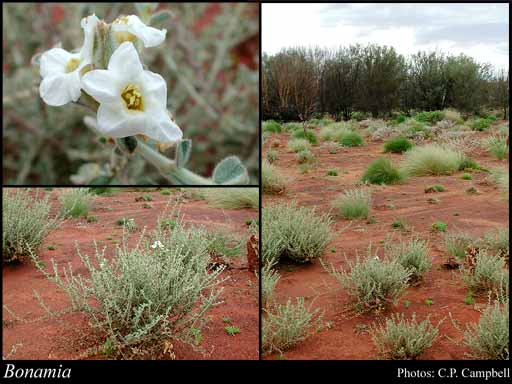- Reference
- Plantae des îsles de l'Afrique australe 33, t. 8 (1804)
- Name Status
- Current

Scientific Description
Family Convolvulaceae.
Habit and leaf form. Herbaceous climbers, or shrubs, or lianas; laticiferous, or non-laticiferous and without coloured juice. Autotrophic. Herbs perennial; plants with neither basal nor terminal concentrations of leaves. Trailing or climbing; stem twiners. Helophytic, mesophytic, and xerophytic. Leaves alternate; spiral; ‘herbaceous’, or leathery; petiolate to sessile; non-sheathing; simple. Leaf blades entire; pinnately veined, or palmately veined; cross-venulate; cordate, or hastate, or sagittate. Leaves without stipules; without a persistent basal meristem. Leaf anatomy. Hairs present (hairs bifid), or absent. Stem anatomy. Nodes unilacunar. Secondary thickening anomalous, or developing from a conventional cambial ring; via concentric cambia, or from a single cambial ring.
Reproductive type, pollination. Fertile flowers hermaphrodite. Unisexual flowers absent. Plants hermaphrodite.
Inflorescence and flower features. Flowers solitary, or aggregated in ‘inflorescences’; when solitary, axillary; in cymes. Inflorescences simple, or compound. The terminal inflorescence unit cymose. Inflorescences axillary; with involucral bracts, or without involucral bracts. Flowers pedicellate to sessile; bracteate; bi- bracteolate. Bracteoles usually small, reduced and scale-like. Flowers small to medium-sized; regular to somewhat irregular. The floral asymmetry (when noticeable) involving the perianth (K only). Flowers 5 merous; cyclic; tetracyclic. Free hypanthium absent. Hypogynous disk present; annular. Perianth with distinct calyx and corolla; 10; 2 -whorled; isomerous. Calyx 5; 1 -whorled; polysepalous, or gamosepalous (rarely, at extreme base only); imbricate; regular to unequal but not bilabiate (subequal or the inner sepals smaller); persistent; non-accrescent; with the median member posterior. Corolla 5; 1 -whorled; gamopetalous; entire, or lobed; plicate; campanulate, or funnel-shaped; regular; hairy abaxially (on mid-petaline band); white, or pink, or yellow, or red, or blue to purple. Androecium 5. Androecial members adnate (to the corolla); all equal to markedly unequal; free of one another; 1 -whorled. Androecium exclusively of fertile stamens. Stamens 5. Staminal insertion near the base of the corolla tube. Stamens remaining included, or becoming exserted (rarely, as in B. alternifolia); oppositisepalous. Filaments glabrous, or hairy; generally filiform above and flattened or widened near the base. Anthers dorsifixed, or basifixed (apparently); dehiscing via longitudinal slits; introrse; tetrasporangiate. Pollen grains psilate. Gynoecium 2 carpelled. The pistil 2 celled. Gynoecium syncarpous; synovarious to synstylovarious (depending on interpretation of partially joined styles); superior. Ovary plurilocular; 2 locular. Gynoecium median. Styles 2 (equal or unequal in length); free to partially joined; apical. Stigmas 2; 1 - lobed, or 2 - lobed; dry type; papillate; Group II type. Placentation basal. Ovules 2 per locule; ascending; apotropous; non-arillate; anatropous.
Fruit and seed features. Fruit non-fleshy; dehiscent; a capsule. Capsules loculicidal (via (2-)4–8 valves), or circumscissile (basally). Fruit 2 locular; (1–)2–4 seeded. Seeds elliptic in outline and plano-convex or trigonous; endospermic. Endosperm oily. Seeds conspicuously hairy, or not conspicuously hairy; winged, or wingless. Cotyledons 2. Embryo chlorophyllous; straight, or curved. Seedling. Germination phanerocotylar.
Physiology, biochemistry. Aluminium accumulation not found. Photosynthetic pathway: C3.
Geography, cytology, number of species. Native of Australia. Not endemic to Australia. Australian states and territories: Western Australia, South Australia, Northern Territory, Queensland, and New South Wales. Northern Botanical Province and Eremaean Botanical Province.
Additional characters Pollen grains colpate. Stigmas the stigmatic area globose (globose, sub-globose, globose-capitate, capitate, conical, reniform or bilobed, rarely peltate).